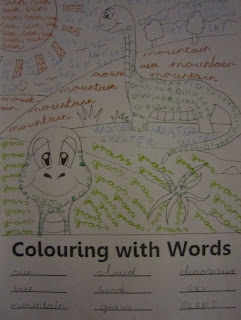Well, I'm finally back online after buying a new laptop. My old laptop died and I lost lots of my files and photos, including many shots of art projects :( I'm also devastated because I lost all of my saved bookmarks, many of which were related to new art projects that I'd been meaning to try. Very annoying!
Anyway, today's ESL art project is Word Aliens/Monsters. I did this with my Grade Two class a few weeks ago and they really enjoyed it. It's a very quick and simple lesson, and it uses pretty basic supplies too.
The three aliens above were the samples that I prepared before my class, but the ones that the kids made were waaaaaaaaay more creative. Many of their aliens had multiple legs, bizarre spikes and even wings. The kids really enjoyed the activity and the aliens looked great displayed on the back wall of the classroom. I especially liked the fact that the kids were able to do some spelling and vocabulary revision without even realising that they were doing it :)
For more info, including step by step instructions, click Read more below.








